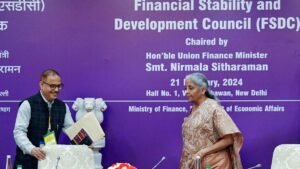
Why in News?
During the 28th Financial Stability and Development Council (FSDC) meeting, the Finance Minister urged financial sector regulators to intensify efforts in curbing the proliferation of unauthorized online lending apps.
What is Financial Stability and Development Council (FSDC)?
- About:
- Established in 2010 by the Government of India, the FSDC is an apex-level body operating under the Financial Stability Division of the Department of Economic Affairs (DEA), Ministry of Finance.
- It was formed in response to the global financial crisis of 2008, following recommendations by the Raghuram Rajan Committee for better regulation of economic assets.
- Composition:
- Chairperson:
- The Union Finance Minister of India presides over the council.
- Members:
- Comprising high-ranking officials such as the Governor of the Reserve Bank of India (RBI), Finance Secretary, Secretary of the Department of Financial Services (DFS), and other key stakeholders from regulatory bodies like SEBI, IRDA, PFRDA, and IBBI.
- Secretary of the Council:
- Additional Secretary, DEA, Ministry of Finance.
- Chairperson:
- Responsibilities or Functions:
- The FSDC is tasked with overseeing and coordinating financial stability and development efforts in India.
- While no specific funds are allocated to the council, it plays a crucial role in formulating policies and strategies to enhance the resilience of the financial system.
- Concerns and Way Ahead:
- The concentration of power within the FSDC, particularly under the leadership of the Union Finance Minister, raises concerns about potential encroachment upon the autonomy of sectoral regulators like the RBI.
- Safeguarding the autonomy of these regulators and establishing functional guidelines to address potential conflicts of interest remains a critical priority for ensuring effective financial oversight and regulation.
What is Digital Lending?
- Digital lending refers to the process of accessing credit online, facilitated through web platforms or mobile applications.
- This modern approach leverages technology across various stages of the lending process, including customer acquisition, credit assessment, loan approval, disbursement, recovery, and customer service.
- Key Features and Drivers of Digital Lending:
- Technology Integration:
- Digital lending platforms utilize advanced technology to streamline processes, offering a seamless and convenient borrowing experience.
- Expanding Smartphone Penetration:
- The widespread adoption of smartphones has facilitated easy access to digital lending platforms, contributing to their popularity.
- Credit Range Flexibility:
- Digital lenders often provide a wide range of credit options, catering to diverse borrower needs and financial profiles.
- Speedy Online Transactions:
- The digitized lending process enables quick approval and disbursement of loans, meeting the demand for rapid financial solutions.
- Products and Examples:
- Buy Now, Pay Later (BNPL):
- BNPL is a popular financing option offered by digital lenders, allowing consumers to make purchases or avail services without immediate payment.
- It functions as a short-term loan product, providing flexibility in managing expenses.
- Buy Now, Pay Later (BNPL):
- Need for Regulation in Digital Lending:
- Proliferation of Illegal Lending Apps:
- India has witnessed a surge in the number of digital loan apps, with a significant portion operating illegally.
- Targeting Vulnerable Populations:
- Low-income and financially inexperienced individuals are often targeted by these illegal apps, offering small-sum loans with exorbitant interest rates and unfavorable terms.
- Exploitative Practices:
- Borrowers, especially those with limited financial literacy, are susceptible to exploitation due to the lack of recourse against unfair lending practices.
- Increased Vulnerabilities:
- Exploiting the unmet need for credit, these practices exacerbate vulnerabilities among borrowers, trapping them in cycles of debt and financial distress.
- Proliferation of Illegal Lending Apps:
- Conclusion:
- Regulating the digital lending sector is imperative to protect consumers from predatory practices and ensure a fair and transparent lending environment.
- Implementing stringent measures can safeguard the interests of borrowers and promote responsible lending practices in the digital era.
- Technology Integration:
People aslo ask
Q1: What is the Financial Stability and Development Council (FSDC)?
Ans: The FSDC is an apex-level body established by the Government of India to oversee and coordinate financial stability and development efforts in the country.
Q2: When was the FSDC formed?
Ans: The FSDC was constituted in 2010 in response to the global financial crisis of 2008.
Q3: What is the composition of the FSDC?
Ans: The FSDC is chaired by the Union Finance Minister of India and comprises key stakeholders such as the Governor of the Reserve Bank of India (RBI), Finance Secretary, and representatives from regulatory bodies and ministries.
Q4: What is digital lending?
Ans: Digital lending refers to the process of accessing credit online through web platforms or mobile applications, utilizing technology across various stages of the lending process.
Q5: What are some examples of digital lending products?
Ans: Products such as Buy Now, Pay Later (BNPL) allow consumers to make purchases or avail services without immediate payment, functioning as short-term loan products.
I don’t think the title of your article matches the content lol. Just kidding, mainly because I had some doubts after reading the article.
thanks for your comments you can ask your douts in comment section i will give the answer
Thanks for sharing. I read many of your blog posts, cool, your blog is very good.